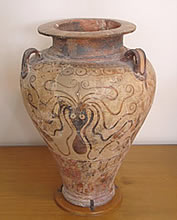




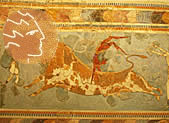

The Minoan Civilization
The Minoan Civilization, Bronze Age civilization, centring on the island of Crete, that flourished c. 3000 to 1100 bc. It was named after the legendary king Minos by the British archaeologist Sir Arthur Evans, who at the beginning of this century excavated Knossos, supposedly the site of Minos’s palace and the capital of his empire, and one of the principal sites of Minoan civilization.
The Main Periods of Minoan Civilization
Evans divided Minoan civilization into three periods:
Early Minoan (c. 3000-c. 2200 bc),
Middle Minoan (c. 2200-c. 1600 bc),
and Late Minoan (c. 1600-c. 1100 bc).
Each of these periods was subsequently subdivided into
Early Minoan I, II, and III
Middle Minoan I, II, and III
and Late Minoan I, II, and III
The Middle and Late Minoan periods were subdivided still further into Middle Minoan IA, Middle Minoan IIB, and so on.
The system of chronology followed here is that devised by the Greek archaeologist Platon:
Prepalatial period (c. 3000-c. 1900 bc)
Protopalatial period (c. 1900-c. 1700 bc)
Neopalatial period (c. 1700-c. 1450 bc)
Final Palace period (c. 1450-c. 1380 bc) and Postpalatial period (c. 1380-c. 1100 bc).
It is based on phases in the building of a succession of palaces at Knossos, and reflects major events in the development of Minoan civilization.
However, since enormous difficulties surround the dating of Minoan civilization, these dates are only very approximate. For the most part Minoan artefacts can be placed only in a relative chronology: for example, one piece of pottery, judged less technically advanced than another, is presumed to be earlier in date. This can fail to take account of the possibility of conservative styles of pottery persisting in one site for longer than in another. Absolute dating can be obtained either by carbon-14 tests (with a margin of error of about 100 to 200 years) or more accurately through the dating of Egyptian artefacts found alongside Minoan finds.
Minoan civilization developed from the culture of the preceding Neolithic period. Evidence obtained from carbon-dating shows that Crete was settled as early as the 7th millennium bc. These early Neolithic inhabitants of Crete lived in simple rectangular houses, in villages set on low hills. They kept livestock, and grew some crops. By the 4th millennium bc, settlement had spread throughout Crete and to a number of small offshore islands.
The beginning of the Prepalatial period (c. 3000-c. 1900 bc) was marked by the arrival of new settlers, bringing with them new copper-working techniques. Two surviving settlements, at Myrtos and Vasiliki, suggest that, during the same period, there was a shift away from a relatively communal living structure (though with defined areas for workshops, kitchens, and storerooms) to a pattern of distinctly separate houses. In the first centuries of the Prepalatial period, a number of new settlements were also established.
During the Protopalatial period (c. 1900-c. 1700 bc) the first substantial palaces of the Bronze Age were built, on the site of the Neolithic settlements at Knossos and Phaistos, and became the focus of an increasingly urbanized way of life. Around c. 1700 bc, the palaces were reduced to ruins, apparently by earthquakes, but were immediately rebuilt, and it is to the subsequent Neopalatial period, (c. 1700-c. 1450 bc) that the majority of the most impressive surviving Minoan buildings belong. The New Palace of Knossos contained not only substantial administrative and residential quarters, storerooms, and workshops but state rooms decorated with lively frescoes. The substantial storerooms argue for a high degree both of economic prosperity and of organization; the plumbing and drainage system suggest an accomplished level of technical efficiency.
Around c. 1450 bc Minoan sites in Crete suffered widespread destruction. This marks the beginning of the Final Palace Period at Knossos (c. 1450-c. 1380 bc). It was once thought that this destruction was caused either by the eruption of Thera (modern Santorini) or by internal strife. However, various strands of evidence point to outside conquest by the Mycenaeans of the Greek mainland: the formalized style of pottery decoration that survives at Knossos after c. 1450 bc bears a greater similarity than to that of mainland Greece than to the naturalistic designs of the earlier Minoan culture; Linear B, the script in which administrative records at Knossos were kept (recognized as an early form of Greek when it was deciphered by Michael Ventris in 1952), strongly resembles that of similar tablets found on the Greek mainland, at Pylos and Mycenae. The damage to Knossos was relatively limited: this and the presence of the Linear B tablets suggest that the town may have served as the administrative capital of Mycenaean Crete.
Knossos itself was destroyed by fire c. 1380, the fire preserving many tablets with inscriptions in Linear B. In the Postpalatial period (c. 1380-c. 1100 bc) many Minoan sites were never reoccupied, though some were reoccupied on a reduced scale, and there some new settlements (for example, Khondros) were established. Economic influence seems to have shifted to the town of Khania, to which a number of vases were imported from Cyprus: it is possible that the town also became the centre of political power in Crete. At the end of the Postpalatial period and the beginning of the Iron Age, a number of fundamental changes occurred that mark the end of Minoan civilization: chief among them was a substantial shift of population to mountain refuge sites and the increasing use of iron rather than bronze for agricultural tools and weapons.
Pottery and Art
Minoan civilization is remarkable for the fine nature of its art. Pottery was made on Crete even from Neolithic times. In the Prepalatial period, however, distinctive new styles of pottery began to emerge; among them were jugs with spouts in the shape of beaks, from c. 2600-c. 2200 bc a plain grey ware with red linear designs, and in the late Prepalatial period style of pottery with white spiral decoration on a dark background. The introduction of the potter’s wheel in the Protopalatial period made possible the so-called Kamares ware, an extremely finely potted ware with a light-on-dark style of decoration. In the Neopalatial period, pottery generally declined, in the variety of its decoration, but the repetitiveness of design is itself a reflection of the technical mastery that had been achieved. Despite the excellence of some types of pottery, fresco-painting seems to have replaced pottery as the innovative medium of the period. The frescoes, that decorate the palaces and villas of the Neopalatial period are extraordinarily naturalistic. The scenes that they portray are both secular and religious: there are magical gardens, monkeys, and wild goats, fancifully dressed goddesses, and depictions of processions, of sport, and of oxhides being stretched and sewn. Superb metalwork was also accomplished: bronzesmiths mastered elaborate techniques of casting, and the gold jewellery was made of fine gold thread decorated with minute grains of gold.
Foreign Contacts
Minoan civilization shows a wide degree of contact with, and influence over, other cultures. Even in the Prepalatial period, there is evidence of Egyptian influence at Knossos, and of the existence of a Minoan colony at Cythera, off the southern Peloponnese. In the Protopalatial period, Egyptian scarabs (seals or amulets in the shape of scarab beetles) began to appear in Crete; late Protopalatial-period pottery has been discovered in Cyprus, Egypt, and the Near East; pottery and stone vases of similar age have been found on both the Greek mainland and the islands of the Aegean. From c. 1600 the influence of Minoan civilization on neighouring cultures increased yet further, especially on the Mycenaean culture of the Greek mainland. The clearest evidence of a Minoan provincial town is the settlement of Akrotiri on Thera (modern Santorini), though there was also substantial influence, if not colonies, on the Cycladic islands of Kea and Melos, and also on Rhodes and Kos. Minoan products reached the Lipari Islands, Asia Minor, Cyprus, the Levant, and Egypt. Minoan Crete seems to have possessed virtually unlimited supplies of copper, probably obtained from Attica on the Greek mainland or from Cyprus, and of tin (an essential component of bronze), from Cornwall, in south-western Britain, Bohemia, or Sinai. Taken together, this evidence seems to lend credence to the ancient Greeks’ belief in the existence of a naval empire centring on Crete and ruled by the legendary Minos. A further piece of evidence is that a number of seaports with the name “Minoa” survived. It has also been suggested that the myth of Theseus and the Minotaur may reflect a later memory of such a naval empire.
Minoan Religion
The subject matter of seals and frescoes discovered at Minoan sites suggests that Minoan culture was steeped in religion. It was a religion centring primarily on female divinities, dominated by the great goddess Potnia to whom offerings of honey were made, and whose symbol was the double axe, the Greek word for which gave rise to the word “labyrinthos”. There seem to have been a number of other divinities (for example, a fertility goddess, a young male deity, a mistress of wild animals, a mountain mother, a goddess of the caves, a tree goddess, and a bull god). It is often hard, however, to determine whether certain outwardly distinct divinities are separate beings or the same divinity represented in a different aspect. A number of the most familiar motifs of Minoan art, the bull or the snake, for example, were most probably religious: the practice of bull-leaping, most famously depicted in a fresco in the palace of Minos, seems to have been a religious ritual.
Minoan religion evolved from the religious beliefs and practices of Neolithic Crete. Female figurines in stone and clay dating from that period resemble those associated with later Minoan religious cults. However, from the Protopalatial period, peak sanctuaries in addition to the earlier cave sanctuaries, began to play a prominent role and temples began to be built on a grand scale: the most famous of these, the labyrinth at Knossos (dating from the Neopalatial period), appears to have been a square structure, approximately 150 m (over 490 ft) wide, containing 300 chambers. There were also changes in burial practice. While the Neolithic custom of burying the dead in caves and rock shelters away from settlements continued, in the Prepalatial period the dead were sometimes placed in clay coffins. Group burials were also made in tholos tombs, domed, circular buildings made of stone with an entrance that faced east. In the Prototpalatial period a new style of burial developed in which the body was placed in a clay storage jar (or pithos).
The Minoan Civilization, Bronze Age civilization, centring on the island of Crete, that flourished c. 3000 to 1100 bc. It was named after the legendary king Minos by the British archaeologist Sir Arthur Evans, who at the beginning of this century excavated Knossos, supposedly the site of Minos’s palace and the capital of his empire, and one of the principal sites of Minoan civilization.
The Main Periods of Minoan Civilization
Evans divided Minoan civilization into three periods:
Early Minoan (c. 3000-c. 2200 bc),
Middle Minoan (c. 2200-c. 1600 bc),
and Late Minoan (c. 1600-c. 1100 bc).
Each of these periods was subsequently subdivided into
Early Minoan I, II, and III
Middle Minoan I, II, and III
and Late Minoan I, II, and III
The Middle and Late Minoan periods were subdivided still further into Middle Minoan IA, Middle Minoan IIB, and so on.
The system of chronology followed here is that devised by the Greek archaeologist Platon:
Prepalatial period (c. 3000-c. 1900 bc)
Protopalatial period (c. 1900-c. 1700 bc)
Neopalatial period (c. 1700-c. 1450 bc)
Final Palace period (c. 1450-c. 1380 bc) and Postpalatial period (c. 1380-c. 1100 bc).
It is based on phases in the building of a succession of palaces at Knossos, and reflects major events in the development of Minoan civilization.
However, since enormous difficulties surround the dating of Minoan civilization, these dates are only very approximate. For the most part Minoan artefacts can be placed only in a relative chronology: for example, one piece of pottery, judged less technically advanced than another, is presumed to be earlier in date. This can fail to take account of the possibility of conservative styles of pottery persisting in one site for longer than in another. Absolute dating can be obtained either by carbon-14 tests (with a margin of error of about 100 to 200 years) or more accurately through the dating of Egyptian artefacts found alongside Minoan finds.
Minoan civilization developed from the culture of the preceding Neolithic period. Evidence obtained from carbon-dating shows that Crete was settled as early as the 7th millennium bc. These early Neolithic inhabitants of Crete lived in simple rectangular houses, in villages set on low hills. They kept livestock, and grew some crops. By the 4th millennium bc, settlement had spread throughout Crete and to a number of small offshore islands.
The beginning of the Prepalatial period (c. 3000-c. 1900 bc) was marked by the arrival of new settlers, bringing with them new copper-working techniques. Two surviving settlements, at Myrtos and Vasiliki, suggest that, during the same period, there was a shift away from a relatively communal living structure (though with defined areas for workshops, kitchens, and storerooms) to a pattern of distinctly separate houses. In the first centuries of the Prepalatial period, a number of new settlements were also established.
During the Protopalatial period (c. 1900-c. 1700 bc) the first substantial palaces of the Bronze Age were built, on the site of the Neolithic settlements at Knossos and Phaistos, and became the focus of an increasingly urbanized way of life. Around c. 1700 bc, the palaces were reduced to ruins, apparently by earthquakes, but were immediately rebuilt, and it is to the subsequent Neopalatial period, (c. 1700-c. 1450 bc) that the majority of the most impressive surviving Minoan buildings belong. The New Palace of Knossos contained not only substantial administrative and residential quarters, storerooms, and workshops but state rooms decorated with lively frescoes. The substantial storerooms argue for a high degree both of economic prosperity and of organization; the plumbing and drainage system suggest an accomplished level of technical efficiency.
Around c. 1450 bc Minoan sites in Crete suffered widespread destruction. This marks the beginning of the Final Palace Period at Knossos (c. 1450-c. 1380 bc). It was once thought that this destruction was caused either by the eruption of Thera (modern Santorini) or by internal strife. However, various strands of evidence point to outside conquest by the Mycenaeans of the Greek mainland: the formalized style of pottery decoration that survives at Knossos after c. 1450 bc bears a greater similarity than to that of mainland Greece than to the naturalistic designs of the earlier Minoan culture; Linear B, the script in which administrative records at Knossos were kept (recognized as an early form of Greek when it was deciphered by Michael Ventris in 1952), strongly resembles that of similar tablets found on the Greek mainland, at Pylos and Mycenae. The damage to Knossos was relatively limited: this and the presence of the Linear B tablets suggest that the town may have served as the administrative capital of Mycenaean Crete.
Knossos itself was destroyed by fire c. 1380, the fire preserving many tablets with inscriptions in Linear B. In the Postpalatial period (c. 1380-c. 1100 bc) many Minoan sites were never reoccupied, though some were reoccupied on a reduced scale, and there some new settlements (for example, Khondros) were established. Economic influence seems to have shifted to the town of Khania, to which a number of vases were imported from Cyprus: it is possible that the town also became the centre of political power in Crete. At the end of the Postpalatial period and the beginning of the Iron Age, a number of fundamental changes occurred that mark the end of Minoan civilization: chief among them was a substantial shift of population to mountain refuge sites and the increasing use of iron rather than bronze for agricultural tools and weapons.
Pottery and Art
Minoan civilization is remarkable for the fine nature of its art. Pottery was made on Crete even from Neolithic times. In the Prepalatial period, however, distinctive new styles of pottery began to emerge; among them were jugs with spouts in the shape of beaks, from c. 2600-c. 2200 bc a plain grey ware with red linear designs, and in the late Prepalatial period style of pottery with white spiral decoration on a dark background. The introduction of the potter’s wheel in the Protopalatial period made possible the so-called Kamares ware, an extremely finely potted ware with a light-on-dark style of decoration. In the Neopalatial period, pottery generally declined, in the variety of its decoration, but the repetitiveness of design is itself a reflection of the technical mastery that had been achieved. Despite the excellence of some types of pottery, fresco-painting seems to have replaced pottery as the innovative medium of the period. The frescoes, that decorate the palaces and villas of the Neopalatial period are extraordinarily naturalistic. The scenes that they portray are both secular and religious: there are magical gardens, monkeys, and wild goats, fancifully dressed goddesses, and depictions of processions, of sport, and of oxhides being stretched and sewn. Superb metalwork was also accomplished: bronzesmiths mastered elaborate techniques of casting, and the gold jewellery was made of fine gold thread decorated with minute grains of gold.
Foreign Contacts
Minoan civilization shows a wide degree of contact with, and influence over, other cultures. Even in the Prepalatial period, there is evidence of Egyptian influence at Knossos, and of the existence of a Minoan colony at Cythera, off the southern Peloponnese. In the Protopalatial period, Egyptian scarabs (seals or amulets in the shape of scarab beetles) began to appear in Crete; late Protopalatial-period pottery has been discovered in Cyprus, Egypt, and the Near East; pottery and stone vases of similar age have been found on both the Greek mainland and the islands of the Aegean. From c. 1600 the influence of Minoan civilization on neighouring cultures increased yet further, especially on the Mycenaean culture of the Greek mainland. The clearest evidence of a Minoan provincial town is the settlement of Akrotiri on Thera (modern Santorini), though there was also substantial influence, if not colonies, on the Cycladic islands of Kea and Melos, and also on Rhodes and Kos. Minoan products reached the Lipari Islands, Asia Minor, Cyprus, the Levant, and Egypt. Minoan Crete seems to have possessed virtually unlimited supplies of copper, probably obtained from Attica on the Greek mainland or from Cyprus, and of tin (an essential component of bronze), from Cornwall, in south-western Britain, Bohemia, or Sinai. Taken together, this evidence seems to lend credence to the ancient Greeks’ belief in the existence of a naval empire centring on Crete and ruled by the legendary Minos. A further piece of evidence is that a number of seaports with the name “Minoa” survived. It has also been suggested that the myth of Theseus and the Minotaur may reflect a later memory of such a naval empire.
Minoan Religion
The subject matter of seals and frescoes discovered at Minoan sites suggests that Minoan culture was steeped in religion. It was a religion centring primarily on female divinities, dominated by the great goddess Potnia to whom offerings of honey were made, and whose symbol was the double axe, the Greek word for which gave rise to the word “labyrinthos”. There seem to have been a number of other divinities (for example, a fertility goddess, a young male deity, a mistress of wild animals, a mountain mother, a goddess of the caves, a tree goddess, and a bull god). It is often hard, however, to determine whether certain outwardly distinct divinities are separate beings or the same divinity represented in a different aspect. A number of the most familiar motifs of Minoan art, the bull or the snake, for example, were most probably religious: the practice of bull-leaping, most famously depicted in a fresco in the palace of Minos, seems to have been a religious ritual.
Minoan religion evolved from the religious beliefs and practices of Neolithic Crete. Female figurines in stone and clay dating from that period resemble those associated with later Minoan religious cults. However, from the Protopalatial period, peak sanctuaries in addition to the earlier cave sanctuaries, began to play a prominent role and temples began to be built on a grand scale: the most famous of these, the labyrinth at Knossos (dating from the Neopalatial period), appears to have been a square structure, approximately 150 m (over 490 ft) wide, containing 300 chambers. There were also changes in burial practice. While the Neolithic custom of burying the dead in caves and rock shelters away from settlements continued, in the Prepalatial period the dead were sometimes placed in clay coffins. Group burials were also made in tholos tombs, domed, circular buildings made of stone with an entrance that faced east. In the Prototpalatial period a new style of burial developed in which the body was placed in a clay storage jar (or pithos).
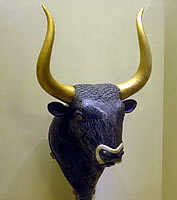
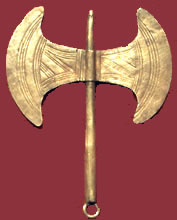
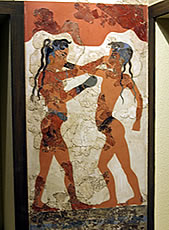
The Minoan cities were connected with stone-paved roads, formed from blocks cut with bronze saws. Streets were drained and water and sewer facilities were available to the upper class, through clay pipes.
Minoan buildings often had flat tiled roofs; plaster, wood, or flagstone floors, and stood two to three stories high. Typically the lower walls were constructed of stone and rubble, and the upper walls of mudbrick. Ceiling timbers held up the roofs.
The materials used in constructing the villas and palaces varied, and could include sandstone, gypsum, or limestone. Equally, building techniques could also vary between different constructions; some palaces employed the use of ashlar masonry whilst others used roughly hewn megalithic blocks.
Minoan buildings often had flat tiled roofs; plaster, wood, or flagstone floors, and stood two to three stories high. Typically the lower walls were constructed of stone and rubble, and the upper walls of mudbrick. Ceiling timbers held up the roofs.
The materials used in constructing the villas and palaces varied, and could include sandstone, gypsum, or limestone. Equally, building techniques could also vary between different constructions; some palaces employed the use of ashlar masonry whilst others used roughly hewn megalithic blocks.
